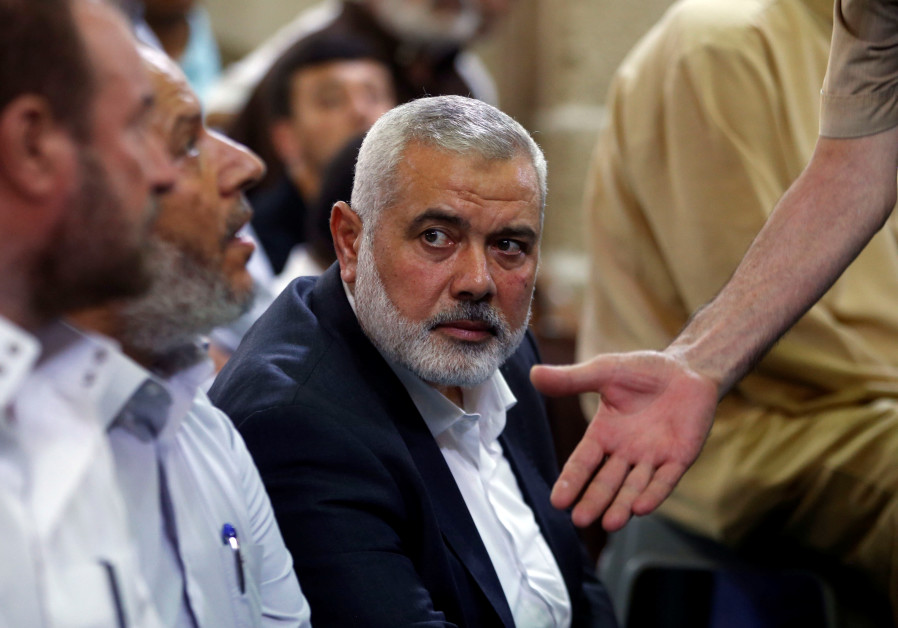Report: Hamas expected to agree to five-year ceasefire with Israel

Hamas Chief Ismail Haniyeh looks on as he attends the funeral of Palestinian Hamas militants who were killed in Israeli tank fire, at a mosque in Gaza City July 26, 2018. (photo credit: MOHAMMED SALEM/REUTERS)
A Hamas delegation from abroad entered the Gaza Strip Thursday from Egypt through the Rafah crossing in order to discuss a proposed ceasefire agreement with Israel.
Under discussion is a comprehensive deal that would entail the improvement of humanitarian conditions in Gaza and the undertaking of large infrastructure projects, including a sea port in the Egyptian city of Ismailia and a Sinai airport, that would serve Gaza residents.
The discussions were reported in the Lebanese daily Al-Akhbar, and some of the reports had already appeared on the website of Maariv, The Jerusalem Post‘s sister publication.
The Lebanese newspaper said that Israel is expected to respond to the proposal next week, which explains Prime Minister Benjamin Netanyahu’s cancellation of his planned trip to Colombia.
The visit by the high-level Hamas delegation resembles that of former Hamas leader Khaled Mashaal to the Strip in 2012, though now Hamas’s second-in-command Saleh al-Arouri is coming to Gaza for the first time. Also taking part in the delegation are Musa Abu Marzouk, Izzat al-Risheq and Husam Badran, who will conduct marathon meetings with Hamas leaders in Gaza. The convoy was held at the Rafah crossing for several hours in order to conduct a thorough search of the vehicles, apparently at Israel’s request. Israel permitted al-Arouri’s entry into Gaza even though his is wanted by Israeli security forces.
The goal of the visit is to reach a decision regarding a long-term ceasefire with Israel, following indirect negotiations between the group’s leaders and Israel, through the auspices of Egyptian intelligence. Hamas’s parliamentary council will take part in the final decision.
Sources close to Hamas said that the agreement will stretch for five years and will be conducted in stages. The first state will entail an end to the weekly protests, dubbed the “Great March of Return,” including the launching of incendiary balloons and kites. In exchange, the Kerem Shalom crossing will be reopened and the Rafah crossing will open permanently.
(function(w,d,s,i){w.ldAdInit=w.ldAdInit||[];w.ldAdInit.push({slot:10834723912266086,size:[0, 0],id:”ld-9628-9059″});if(!d.getElementById(i)){var j=d.createElement(s),p=d.getElementsByTagName(s)[0];j.async=true;j.src=”//cdn2.lockerdomecdn.com/_js/ajs.js”;j.id=i;p.parentNode.insertBefore(j,p);}})(window,document,”script”,”ld-ajs”);
The second stage involves improving the standard of living of Gaza residents and the total removal of the blockage on the Strip. In parallel, Israel will allow the entry of all all manner of goods into Gaza and will increase the amount of electricity in the Gaza power grid.
In the third stage, the United Nations will begin work on humanitarian projects that it had approved in the past, such as the construction of a port in Ismalia in Egypt, opening an airport on Egyptian territory, constructing a power station in the Sinai Peninsula, and, finally, a thorough rebuilding of the Strip.
The plan was presented last week by the United Nation’s special representative to the Middle East, Nikolay Mladenov, to Hamas’s leader Ismail Haniyeh, in order to prevent a further escalation of the situation after an IDF tank killed two Hamas operatives.
Among other proposals, Mladenov suggested opening the Kerem Shalom crossing, expanding the area open to fishing, and then increasing the power supply to Gaza to add another four hours of electricity per day, as well as transferring 31 million dollars worth of aid from Qatar and promising 91 million dollars for the UNRWA refugee agency. An additional 10 million dollars would serve to pay the salaries of Palestinian Authority employees in the Gaza Strip, so that they receive eighty percent of their salaries instead of the half that they do today. The issue of Hamas salaries would be solved two months later.
In any case, the proposals received a less-than-enthusiastic response from Hamas in Gaza. “The solution does not live up to our expectations. We need a sea passage to a port in Cyprus without Israeli supervision,” the organization said.
However, after marathon meetings in Cairo, including a visit from the UN representative, an almost-final agreement has been reached. Hamas is expected to announce its agreement by the end of the weekend, and the Israeli cabinet is expected to approve the deal when it meets on Sunday.
Palestinian sources confirm the reports in Maariv yesterday that an exchange of prisoners will only be discussed in the second stage, though preliminary contacts would begin two months after the announcement of the ceasefire.
“Hamas’s condition is that Israel must release those first released as part of the Schalit deal who were arrested again,” emphasized a Hamas source who spoke with the Lebanese newspaper. The source also expressed his concern that Palestinian President Mahmoud Abbas may delay or undermine the ceasefire, which would be agreed to by all the Palestinian factions in Gaza.






Comments are closed.